Visit a Library of Wonders
With an introduction by Page Harrington, chief of the Visitor Engagement Office, this is a guest post by several members of that office. It also appears in the July-August issue Library of Congress Magazine.
The nation’s capital is a visitor’s delight: Few places in the United States, if any, pack so many binge-worthy historical and cultural sights into such a compact area.
And few places in Washington, if any, can match the Library’s Thomas Jefferson Building for sheer beauty and inspiration. The Jefferson opened in 1897 as the Library’s first stand-alone building, the largest library building in the world. Its dazzling decoration and soaring architecture made it a source of national pride, and its program of sculpture and painting made it a monument to civilization, imagination and knowledge. It’s easy to find out how to visit us, and we hope you do.
Meanwhile, here are some of the VEO staff favorites.
Main Reading Room Statues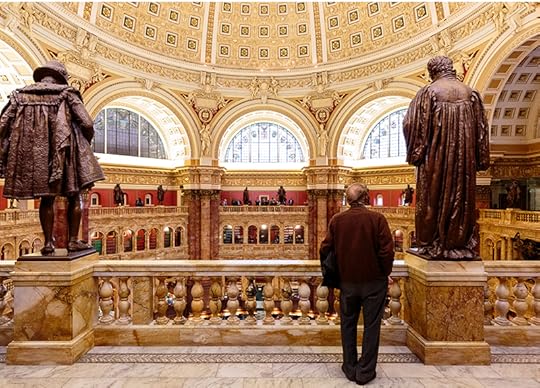 A visitor stands on the balcony of the Main Reading Room, flanked by two statues. Photo: Shawn Miller.
A visitor stands on the balcony of the Main Reading Room, flanked by two statues. Photo: Shawn Miller.One of the most impressive features of the Main Reading Room are the statues that adorn the room’s balconies and columns. Atop each of the eight marble columns surrounding the room stands a 10-foot allegorical figure representing an area of thought: religion, commerce, history, art, philosophy, poetry, law and science.
These allegorical figures are draped in symbolic clothing and props to communicate their discipline: The history figure holds a book and a mirror facing backward to reflect the past; science holds a globe and a mirror facing forward to reflect progress.
Each figure is flanked by bronze statues (16 in total) representing major contributors to that field. Beethoven, for example, stands on one side of art and Michelangelo on the other.
Together, these symbolic and representative statues convey an 1897 perspective on global contributions to eight core disciplines of knowledge.
—Colette Combs, Visitor Engagement Technician
“Evolution of the Book” John White Alexander’s “Printing Press” mural in the Jefferson Building. Photo: Shawn Miller.
John White Alexander’s “Printing Press” mural in the Jefferson Building. Photo: Shawn Miller.On the east side of the Great Hall, you will see six lunette paintings that make up “The Evolution of the Book,” by com American painter John White Alexander in 1895.
The series begins on the south end with “The Cairn,” depicting an ancient civilization building a ceremonial mound to commemorate its dead or mark an important location. “Oral Tradition” and “Egyptian Hieroglyphics” follow, portraying early storytelling in two forms. In “Oral Tradition,” a storyteller speaks to a crowd; in “Egyptian Hieroglyphics,” two figures chisel written words into a building exterior.
The north side of the Great Hall houses “Picture Writing,” which shows Native Americans drawing on animal hides that could be easily transported and traded. Finally, “Manuscript Book” and “Printing Press” work in tandem to portray how Johannes Gutenberg revolutionized book production with the creation of metal movable type.
—Shannon McMaster, Visitor Engagement Technician
Minerva Mosaic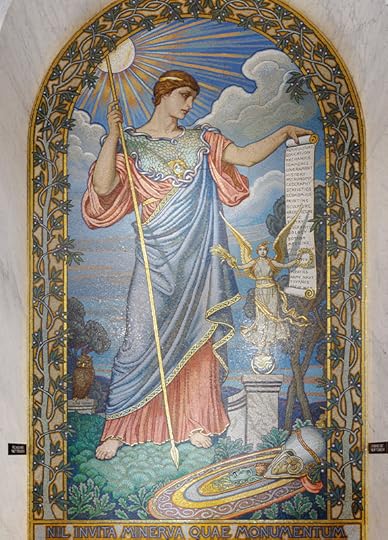 The Mosaic of Min
erva
, by Elihu Vedder, is on the seccond floor and east corridor of the Jefferon Building. It is within an central arched panel leading to the visitor’s gallery. Photo: Shawn Miller.
The Mosaic of Min
erva
, by Elihu Vedder, is on the seccond floor and east corridor of the Jefferon Building. It is within an central arched panel leading to the visitor’s gallery. Photo: Shawn Miller.In vibrant mosaic tiles, Minerva, the Roman goddess of learning, knowledge and defensive warfare, stands atop the staircase outside the Main Reading Room.
She is at peace: Her spear points to the ground, and her helmet and shield lie at her feet. If there’s peace, learning can advance. In her left hand, Minerva holds a scroll that lists fields of study important to civilization. The scroll is not fully unfurled, suggesting that we always are adding new fields of study to what we consider important.
Just behind sits Minerva’s owl. We all know the owl to be a symbol of wisdom. I like to think this is because an owl can turn its head 270 degrees. It is constantly learning new pieces of information, adding them to its fund of knowledge and changing its mind when called for — this is what makes it wise.
—Rod Woodford, volunteer specialist
Stained-glass Ceiling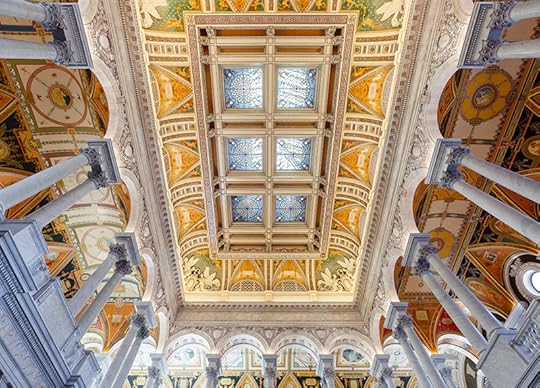 The ceiling in the Great Hall. Photo: Shawn Miller.
The ceiling in the Great Hall. Photo: Shawn Miller.When you are in the Great Hall, look up at the stained-glass windows of the ceiling. These six beautiful, Tiffany-era glass suns reflect the mosaic on the floor below.
Surrounding the glass, you see metallic leaf. Often mistaken for silver, this is actually aluminum. During the construction of the Jefferson Building, aluminum was rare because of the electricity required to produce it, making it one of the most valuable metals in the world.
Adding to the opulence of the Jefferson Building, aluminum leaf was used alongside gold leaf to accent the Great Hall artwork.
—Danielle Brown, Visitor Engagement Technician
Thomas Jefferson’s Library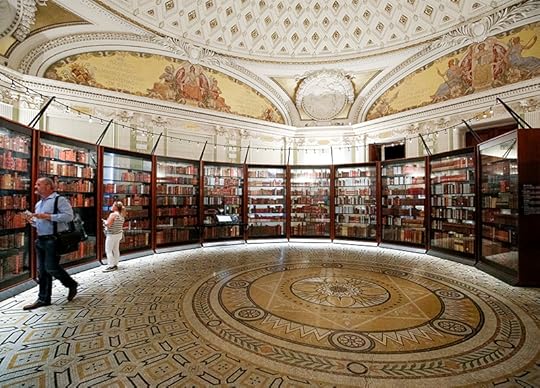 Thomas Jefferson’s personal library, carefully preserved but on public view, is one of the Library’s most popular exhibits. Photo: Shawn Miller.
Thomas Jefferson’s personal library, carefully preserved but on public view, is one of the Library’s most popular exhibits. Photo: Shawn Miller. Thomas Jefferson’s personal library is an essential part of the Library’s early history — and, today, it’s one of our most sought-out exhibitions.
British troops burned the Capitol Building in 1814, destroying the Library and all of its holdings. The following year, Congress purchased 6,487 books from Jefferson for $23,950 to help rebuild the Library’s collections.
Then, in 1851, devastating fire then destroyed two-thirds of those books. But the remaining volumes are on permanent display today in the building named after Jefferson, allowing visitors to see what is considered the core foundation of the Library’s modern-day collections.
As you go around the circular room, be sure to note some of Jefferson’s interests in literature, including books on beekeeping and winemaking!
—Jessica Castelo, Visitor Engagement Technician
“Touch History” Tours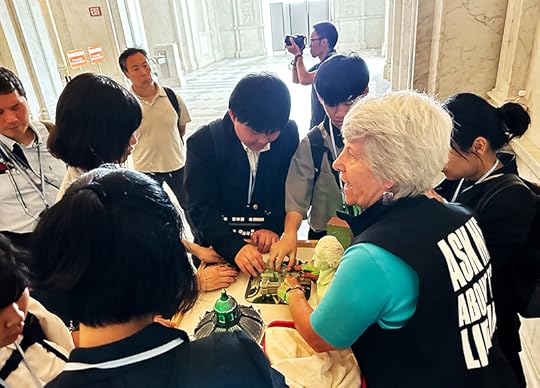 A docent assists visitors on a “touch history” tour of the Library. Photo: Shawn Miller.
A docent assists visitors on a “touch history” tour of the Library. Photo: Shawn Miller. You can also experience the Library through a sense of touch – visually impaired visitors get a sense of the Jefferson Building’s grandeur through our “Touch History” tours.
In the Great Hall, tactile learning opportunities abound: incised brass sun and zodiac symbols embedded in the floor, smooth busts of Thomas Jefferson and George Washington, wall-mounted brass faces reminiscent of Medusa. The sleek Carrara marble walls and columns, interrupted by raised, decorative moldings, offer a contrast of surfaces. Docents provide detailed descriptions of each, putting the items in context.
Most captivating are the marble putti — sculpted chubby little boy figures cascading down both balustrades of the grand staircases. These 16 figures represent common professions and pursuits when the building opened in 1897.
Two putti are within arm’s reach: The gardener, equipped with a hoe and rake, and the mechanic, holding a long-necked oil can and cogwheel. Most visitors can easily reach the statues’ toes – and the adjacent sculpted storks – while docents describe their size, posture, attire and expressions, enriching the tactile experience.
— Kathy Tuchman, Robert Horowitz and Karyn Baiorunos are volunteer docents.
Subscribe to the blog— it’s free!
Library of Congress's Blog
- Library of Congress's profile
- 73 followers



